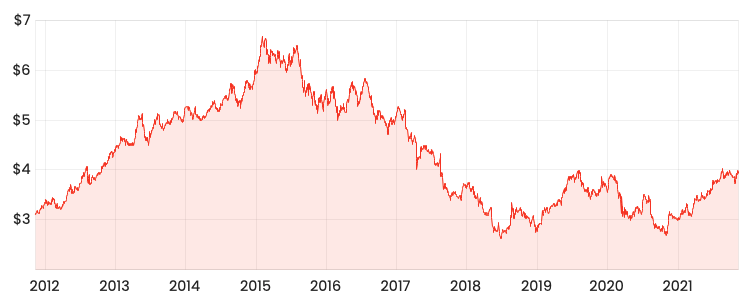The Telstra Corporation Ltd (ASX: TLS) share price resembles somewhat of a rollercoaster. But not in a fun way.
TLS share price

In fact, all the way back in 1997 when Telstra was privatised, shares were first sold for $3.30.
If you bought them then, you would have received less than a 1% per annum return.
Notwithstanding its past underperformance, here’s why I think it’s time to add Telstra shares back on your watchlist.
The curse of the nbn
Before delving into why you might consider Telstra for your watchlist, it’s worth reminding ourselves why it’s been on the no-go list for so long.
Over the past ten years, Telstra has faced several challenges including falling telco prices and the entrance of disruptive competitors such as TPG Telecom Ltd (ASX: TPG).
However, no doubt the biggest challenge to Telstra has been the national broadband network (nbn).
Originally, Telstra was able to sell its network to other carriers to use.
However, in 2011 (and later revised in 2014), Telstra agreed to sell its existing copper network to the NBN.
As compensation, Telstra would receive annual payments until the nbn was completed.
“Overall, the forecast net effect on our business is a reduction of $2-3 billion in EBITDA per annum at the conclusion of the nbn™ build” – Telstra FY16 Annual Report
The idea was that the payments would be reinvested into new areas to replace the lost network earnings.
Unfortunately for shareholders, Telstra failed to plug the gap. It made mostly poor acquisition choices. Meanwhile, its cost base ballooned.
Market share for nbn declined from 50% to 45%. Retail mobile services grew at a measly 2.5%.
As a result, EBITDA dropped from $10.5 billion in 2016 to $7.6 billion in 2021.
But the real knockout punch was the dividend cut.
The much-heralded cheque received by over one million shareholders was slashed from 31 cents to 15 cents per share.
“The reality is that Telstra has lost over $6 billion of profit in the last decade or so, predominantly from the impact of the nbn but also the loss of voice revenues, sms revenues, global roaming and other pressures” – Chairman John Mullen
Leaner and meaner
To combat the share price decline, in 2018, Telstra announced T22 – a cost-cutting strategy to mitigate the impact of the lost revenue to the NBN.
At the time, the market was pretty sceptical.
Could Telstra really turn things around?
You bet.
Consumer and Small Business plans were reduced from 1,800 to 20. Four management layers were removed. Over a third (25,000) of staff were shown the door.
The business also decided to monetise its assets. It sold a 49% stake in its towers business for $2.8 billion with further divestments on the horizon.
Telstra stripped out $2.3 billion of costs, with a further $400 million to come next year.
With T22 largely complete, management has regained the trust of the market.
Subsequently, the Telstra share price has bounced over the past year.
Ready for take-off
With costs and market expectations reset, Telstra is ready to launch.
At its investor day last month, Telstra announced its updated strategy, T25.
“If T22 was a strategy of necessity, T25 is a strategy for growth” – Chairman John Mullen
Growth hasn’t exactly been a word used to describe Telstra in the past.
But its ambition is to grow EBITDA at mid-to-high single digits over the next five years.
Further costs will be stripped out while the customer experience will be a primary focus.
The company wants to address 90% of customer queries in one engagement. No callbacks or multiple conversations. One and done.
Final thoughts
Investors have a right to be sceptical of the T25 plan.
Taking out costs is one thing. Attracting new customers after years of stagnant growth is another beast.
But given the success of T22, it’s worth at least tracking Telstra over the medium term.
With a 3.0% fully franked dividend yield, which should be protected by earnings growth, Telstra may no longer be the rollercoaster it once was.









